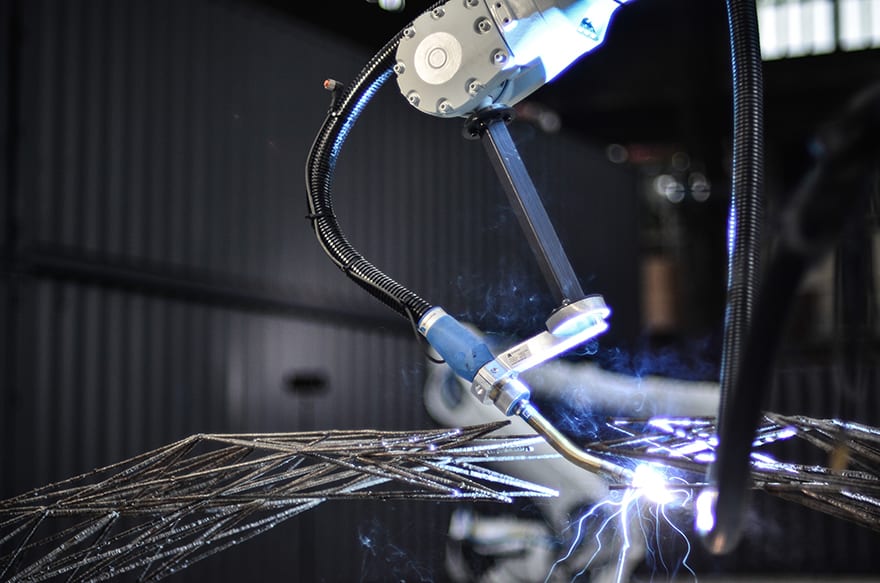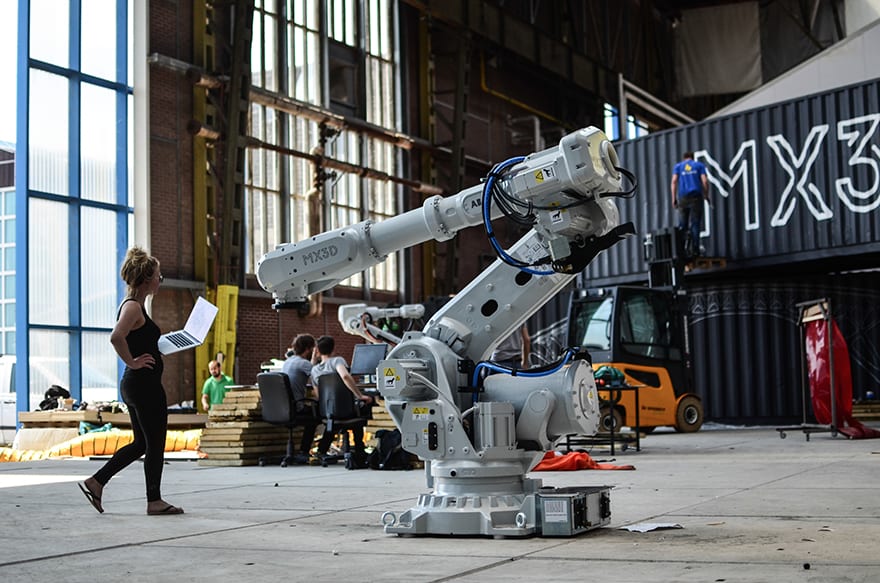A tech start-up and a large Dutch contractor planning to build the world’s first 3D printed steel bridge using two automated robots will open a new facility to test the complex software and robotics next month.
The project is being led by Dutch research start-up MX3D, in collaboration with software firm Autodesk, construction contractor Heijmans, robotics supplier ABB and computer maker Lenovo.
The project to build the bridge over a canal in Amsterdam is being hailed as the start of a revolution when digital fabrication enters the world of large-scale, functional objects made from durable materials.
The test facility, in a large shipping wharf building in the north of Amsterdam, will be used to complete software development work to enable the system to translate 3D models into a printing strategy, and also to create a language to control the industrial robots.
The modified robots feature multi-directional welding nozzles, guided by Autodesk’s software, which will “draw” the bridge in situ, working from one bank of the canal to the other. The team is currently consulting with the City of Amsterdam to determine where the bridge will be located and construction is due to start in Spring 2017.

The robots have multi-directional welding nozzles which will “draw” the bridge in situ
Tim Geurtjens, chief technology officer at MX3D, told BIM+: “The main challenge is ensuring that the robots know their position in space, from one moment to the next, and in relation to the bridge as it is being printed.
“Another significant aspect is the design for the robots’ propulsion system. We are currently looking at either a wheel or track system, or a system using special grips able to move the robot forward one position at a time as welding progresses.”
Detailed strength calculations must be carried out to ensure the bridge is able to support its own weight, plus that of the robots riding on top.
Read related articles
Skanska to build first commercial 3D concrete printing robot
Start-up’s ‘game-changing’ 3D printer inspired by Terminator 2 film
3D printing technology enters uncharted territory
However, Geurtjens warned that windy weather and potential hazards related to the welding process might require the bridge to be constructed in an offsite facility, rather than directly over a canal in the city centre.
He said: “If we want to print the bridge outside, we will have to protect it from the wind, otherwise the shielding gases, used during welding, would just blow away. We still have to figure out a way to do that. This is a development process and the technology is not there just yet.”
The intense light produced when welding is another concern, and a potential hazard to bystanders, he added. “We hope we can use the robots live at the location where the bridge will stand, but that will depend on where it is, if it is too busy we might consider printing offsite, where there are fewer people, then move the completed structure into position.”
The 3D printing technique is a form of welding, adding small amounts of molten steel to stainless steel to fuse them together. As consecutive layers are built up, a solid and robust monolithic structure is formed, eradicating the need for supporting structures.

Contractor Heijmans sees robots as a way of transferring “dirty, dull and dangerous” jobs done by humans
If the technique works outside it could usher in a new era of construction, enabling the robotic printing of large-scale structures on sites. In addition, the use of robots could avoid potential safety issues related to working at height or in difficult, hard-to-reach locations.
Geurtjens added: “Dutch major contractor Heijmans is very interested in this because they see it as a possibility to transfer the ‘three Ds’ normally carried out by humans – the dirty, dull and dangerous jobs – to robots. Basically, the jobs people don’t want to do, or cannot do.”
He added: “What is unique and exciting about this collaboration is that all the sponsors are also the project partners and have a vested interest in making it work for their businesses, which should really speed the development process.”
Based on initial tests and printing speeds achieved, MX3D predicts printing the bridge will take around three months. The final design should be complete in about a year.
Dutch major contractor Heijmans is very interested in this because they see it as a possibility to transfer the ‘three Ds’ normally carried out by humans – the dirty, dull and dangerous jobs – to robots.– Tim Geurtjens, chief technology officer, MX3D
Comments
Comments are closed.












The use of such robots is not new but the taking of them to the next level is new. Is it now time to rethink our possible relationship with such technology in the future, There are always people prepared to the work to feed and sustain themselves and family, what has has to be thought about, is there a price too expensive for society to pay in terms of loss of pride, job satisfaction and indeed having a job at all, and with the advent of personal robots , the very interaction between people.